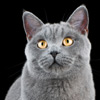|
The Scratching Post
British Shorthair 
The British Shorthair has a powerful and compact build. It has a full broad chest and short legs. The head is round and massive. The nose is broad with a gentle dip. The muzzle is distinctive and the ears are medium, broad at the base and rounded at the tips. The eyes are large, round and well-opened. The paws are round and firm and the tail is medium in length and tapers slightly to a rounded tip. The short coat is very dense and firm to the touch, similar to a deep pile carpet.
|
|
Temperament
|
A British likes to be around you and by you. They will follow you, watch you and basically supervise all aspects of life in their house. They simply do not like to be "controlled." They have lasting patience and confidence and are good with children and other household pets. British are very easy going and are affectionate to the people they consider family. Being a larger heavy cat, they feel very uncomfortable off the ground.
|
|
Weight
|
Male 12-18 lbs. ; Female 8-11 lbs.
|
|
Health Problems
|
The British Shorthair, on a whole, is a very healthy and long lived breed. Minor concerns include gingivitis, which will cause an affected cat to require careful dental care, and cardiomyopathy. Do not let your British gain weight as this will shorten its lifespan.
|
|
Living Conditions
|
Keeping your British Shorthair inside will limit its exposure to fleas and intestinal parasites. This non-destructive breed will adapt well to any size household.
|
|
Exercise
|
This breed is very active and loves to follow you from room to room. They get plenty of activity indoors.
|
|
Life Expectancy
|
14-20 years
|
|
Grooming
|
The coat of this breed needs minimal care yet has a luxurious feel.
|
|
Origin
|
The British Shorthair is said to have originated from the common domestic cat of ancient Rome. They were said to have been brought with the Romans when they invaded and ruled England nearly 2000 years ago. Throughout the years, these cats bred among themselves on the relatively secluded island ? possibly cross-breeding with local wild cats. During the 19th century, the interest in pedigreed cats flourished in Victorian Britain. As exotic cats from near and far arrived, some breeders decided to recreate the local British Shorthair as a pedigree. In 1871, British shorthairs were shown as a breed in the Crystal Palace Cat Show. The British Shorthair was recognized by a major cat association in 1980. This is the breed of cat that Lewis Carroll used in Alice In Wonderland; The Cheshire Cat.
|